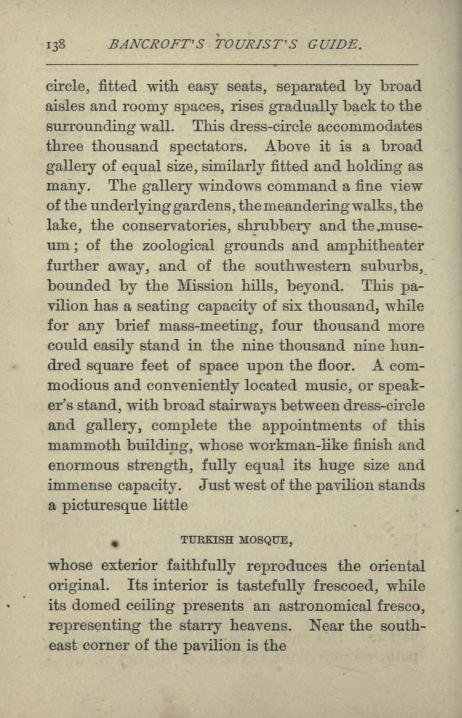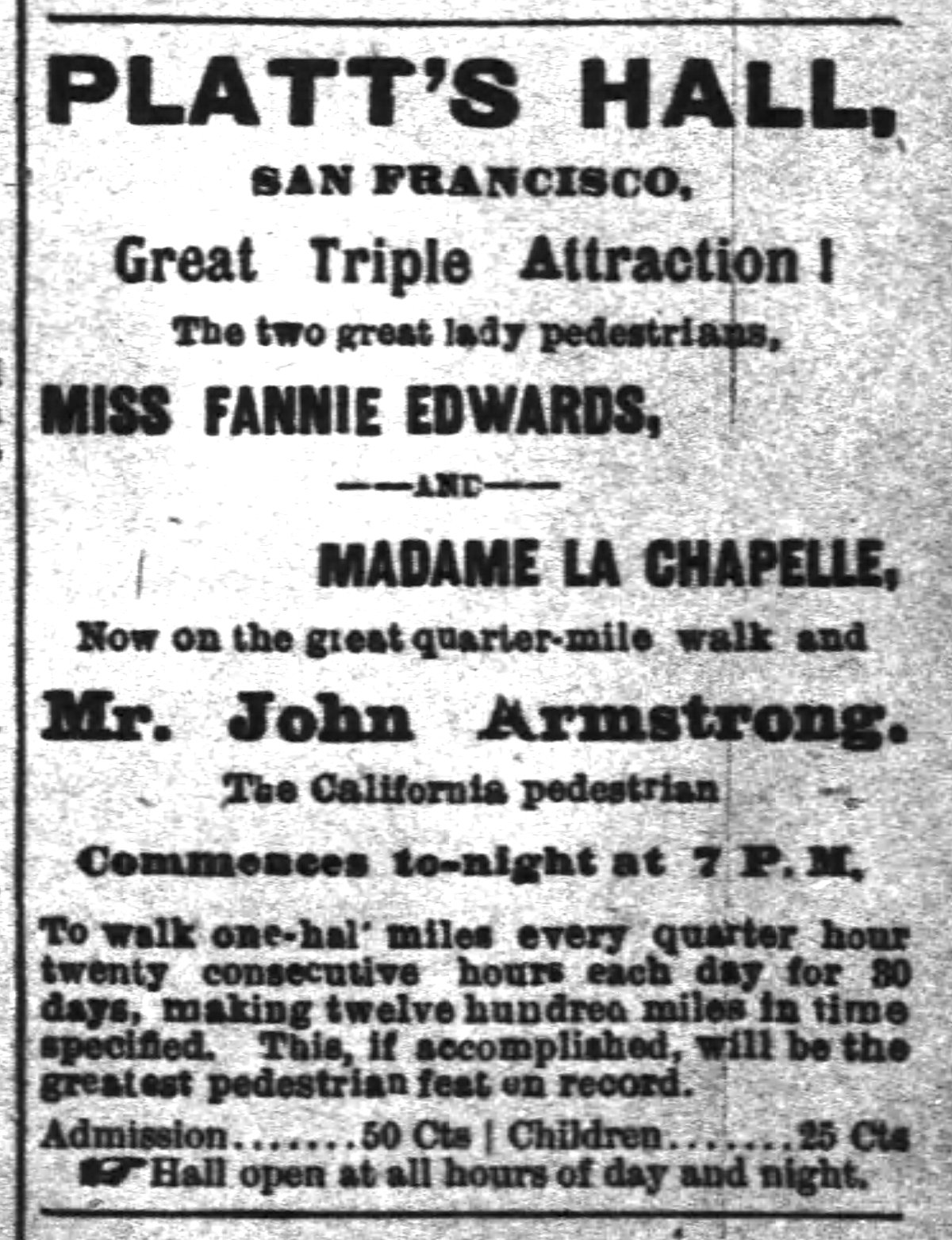The Sporting Emperor Norton
He Liked to Play — and to Watch Others Play
LOCAL newspapers often spotted Emperor Norton at sporting events.
As far as we know, the Emperor wasn’t much of an athlete himself. But, he did like to try his hand at amusements that required a degree of physical skill and mastery. This may help to explain why — as we’ll see shortly — races and tournaments of various kinds seemed to hold an abiding interest for him.
A well-known early example of Emperor Norton’s “recreational impulses” took place during his appearance at the Mechanics’ Pavilion, at Stockton and Geary Streets, San Francisco, in early March 1869. A “velocipedestrian training school” was being held inside. Outside, the Emperor mounted a boneshaker himself — and, Eadweard Muybridge a.k.a. Helios was on hand to capture the feat on film:
Emperor Norton on a boneshaker, early March 1869. The photograph was taken by Eadweard Muybridge (1830–1904) outside the Mechanics’ Pavilion, at Stockton and Geary Streets, San Francisco, where a “velocipedestrian training school” was being held. Collection of the Bancroft Library, UC Berkeley (part of the Lone Mountain College Collection of Stereographs by Eadweard Muybridge, 1867-1880).
It would be reasonable to guess that Muybridge prompted Emperor Norton to mount the new contraption. But, the report of the episode in the Daily Alta California newspaper leaves open the possibility that the initiative was the Emperor’s.
Item on Eadweard Muybridge’s photograph of Emperor Norton on a boneshaker, Daily Alta California, 8 March 1869, p.1. Source: California Digital Newspaper Collection
:: :: ::
A YEAR-AND-A-HALF later, a new amusement supplanted “velocipeding” as the latest fad: On 23 August 1870, a two-liner in the Daily Alta announced that roller skating was about to be introduced at Union Hall:
Item announcing the introduction of roller skating at Union Hall, Daily Alta California, 23 August 1870, p.1. Source: California Digital Newspaper Collection
Alas, if Emperor Norton had noted the fine print in Union Hall’s ad that appeared a few days later, he might have opted to save himself the embarrassment of trying to attend but being turned away: “The Management…will refuse admission to all not of genteel appearance.”
The Emperor wouldn’t have to wait long for another opportunity. In January 1871, the Alta noted that Woodward’s Gardens — the popular resort within the area bordered by 13th, 15th, Mission and Valencia Streets — was in the process of building a new circular skating rink that would be 95 feet across.
Item noting circular skating rink being built at Woodward’s Gardens, Daily Alta California, 14 January 1871, p. 1. Source: California Digital Newspaper Collection
In fact, the skating rink was being built inside a new “mammoth pavilion” under construction at Woordward’s Gardens. The pavilion opened on 22 April 1871, with skating underway by May Day.
In this c.1875–80 photograph by Carleton Watkins, the pavilion — with a footprint in an elongated octagon shape — visible at top left:
Boudoir card view of Woodward’s Gardens, San Francisco, from Mission Street looking northwest, c.1875–80. Photograph by Carleton Watkins (1829–1916). Source: Calisphere
Here’s a closer look:
The Bancroft’s Tourist Guide of 1871 offered a nice description of the new pavilion and skating rink (click to enlarge individual pages):
Descriptions of the “mammoth pavilion” and skating rink at Woodward’s Gardens, Bancroft’s Tourist Guide: Yosemite; San Francisco and Around the Bay (South), 1871, pp. 137–138. Source: Internet Archive
So it was, with all these pieces in place, that Emperor Norton in early March 1872 made his way to Woodward’s Gardens, apparently hoping that the outing would include a few turns around the rink.
Alas, the Emperor was refused skating privileges — so, he took to the Pacific Appeal with the following Proclamation, which was published on 16 March 1872:
Proclamation of Emperor Norton on his prerogative to skate at Woodward’s Gardens, Pacific Appeal, 16 March 1872, p.4. Source: California Digital Newspaper Collection
When the skating rink at Woodward’s Gardens opened the spring before, the Alta noted that admission to the Gardens included admission to the rink.
Item on skating rink admissions policy at Woodward’s Gardens, Daily Alta California, 4 May 1871, p. 1. Source: California Digital Newspaper Collection
Assuming that this policy still was in place in March 1872, Emperor Norton would have expected to be granted access to the skating rink as part of his 25-cent fee of admission to Woodward’s Gardens. And, he wouldn’t have been at the rink if he weren’t already inside the Gardens.
Which leads to the conclusion that, whether or not Woodward’s Gardens had a formally stated Union Hall-like “genteel appearance” policy for admission to the Gardens as a whole, staff of the Gardens must have had wide latitude to admit — or officiously to bar — whomever they wished from individual amenities.
The Emperor might have briefly have sought skating comforts in Oakland:
But, it appears that, by May 1872, Emperor Norton and Woodward’s Gardens had worked things out. The Emperor appeared on the rink at a May Day-themed children’s festival at the Gardens. As evidenced by the San Francisco Chronicle’s report, though, the event might have left the Emperor rethinking his interest in skating:
A conspicuous figure on the floor of the skating rink was his Serene Highness, the Emperor Norton. His industry and perseverance did not compensate, however, for lack of grace and dexterity, and after assiduously shambling around the amphitheater for half an hour or so the imperial heels flew up and the imperial stern struck the floor so vigorously that the building trembled at the shock. Then the Emperor abdicated the skates.
:: :: ::
A FINAL brief entry in the “Emperor’s recreation” category:
On 14 June 1873, the Caledonia Club held its seventh annual picnic and "Scotch Games" at Badger’s Grand Central Park, in Oakland.
The next day, the Daily Alta reported that Emperor Norton was in attendance and that he "engaged in jumping rope with the ladies, which scene was heartily enjoyed by the bystanders."
Was the Emperor the one doing the jumping — or was he just twirling one end of the rope?
Excerpt from article, “Scotch Games: Annual Picnic of the Caledonia Club,” Daily Alta California, 15 June 1873, p.1. Source: California Digital Newspaper Collection
:: :: ::
AFTER 1873, the documentary record shows us an Emperor Norton who, after age 55, may have shifted from being a participant in recreational amusements to being a supporter and spectator of competitive sport.
On 20 November 1874, the verbosely named San Francisco Weekly Stock Report and California Street Journal reported on a closely watched horse race that had taken place at the Bay District Fair Ground’s new Inner Richmond race track six days earlier, on the 14th.
Here’s a photograph of the track that Carleton Watkins took on the day of the race:
View of the Bay District Fair Grounds race track, San Francisco, 14 November 1874. Photograph by Carleton Watkins (1829–1916). Collection of the California State Library. Source: CarletonWatkins.org
In the course of the article, the paper noted that Emperor Norton was amongst those seen at the race.
Given the humorous, pulling-your-leg tone of the article and the fact that the list of "Notable Persons Present" that includes the Emperor also includes James Lick and Adolph Sutro, it probably has to be admitted that the list could be a literary device to suggest that "everybody who was anybody was there."
But, given Emperor Norton's well-documented attendance at places of public amusement — such as Woodward's Gardens — it's very possible that he was indeed at the races on 14 November 1874.
Indeed, the fact that the legendary Carleton Watkins took a photograph of the race track on that particular day lends credence to the possibility that everybody who was anybody really was there — including Emperor Norton.
:: :: ::
TWO REPORTS from 1879 tell us that Emperor Norton — who died in January 1880 — continued to attend sporting tournaments throughout his life.
In the 1870s, endurance walking became one of the most popular spectator sports in the United States. At the end of the decade, 24 May 1879 saw the beginning of a heavily promoted — and betted — walking match at Platt’s Hall, San Francisco: 1,000 miles in 1,000 hours, between Hilda La Chapelle and Fanny Edwards.
Also in the field was John Armstrong, who was competing against himself in an effort to clock 1,200 miles on 30 days. Armstrong began his walk on the 26th:
Here’s how the Daily Alta reported on Armstrong’s early progress:
Excerpt from “Perservering Pedestriennes,” article on walking match at Platt’s Hall, San Francisco, Daily Alta California, 28 May 1879, p. 1. Source: California Digital Newspaper Collection
Two weeks in, on June 12th, the Emperor made an appearance. Evidently, part of his mission was to greet Armstrong and wish him well:
On June 26th and in the days following, papers from coast to coast reported that, on the evening of the 25th — 30 days after he began — John Armstrong accomplished his unprecedented feat:
:: :: ::
SIX MONTHS later, in December 1879, Emperor Norton was back at Platt’s Hall to watch a different kind of sport: wrestling.
The three-days wrestling tournament opened very successfully at Platt’s Hall last evening. By 8 o’clock athletic enthusiasm and the dulcet yawns of a coterie of brass instruments had filled the hall with wrestlers of every degree, from the wildcat fighter of Pine Street to the free-lunch tusslers from Pauper alley, the present Regent of whom, Emperor Norton, looked with sovereign gravity on the exciting spectacle from near the door.
No doubt, other newspaper reports of Emperor Norton’s sports spectatorship will show up over time. Many of the examples here, I turned up in the course of looking for other things.
But, the Emperor’s appearance at this December 1879 wrestling tournament seems worth noting for a couple of reasons:
(1) This appears to be the last sighting of Emperor Norton reported in a newspaper until the day of the Emperor’s death a little more than two weeks later.
(2) Of coincidental interest: The Emperor attended the tournament on 22 December 1879 — 27 years, to the day, after — as Joshua Norton — he signed the fateful rice contract of 22 December 1852 that would change his life forever.
And, what was he there to watch? Wrestling — a high-stakes game of calculated skill and risk.
Sometimes, truth really is stranger than fiction.
:: :: ::
For an archive of all of the Trust’s blog posts and a complete listing of search tags, please click here.
Search our blog...




















